Evaluation of Human Factor Program: Aerospace Engineering Department
VerifiedAdded on 2022/12/27
|22
|4801
|149
Report
AI Summary
This report presents an evaluation plan for the human factor program within the Aerospace Engineering Department, employing Stake's countenance model for assessment. The report begins with an executive summary, followed by an introduction outlining the project's aim and the application of Stake's model. It then details the background, purpose, and intended audiences of the evaluation. The report addresses key decisions and questions, outlines the evaluation methods, and provides a plan for implementation. Furthermore, it analyzes the human factor performance based on organizational weaknesses, including training, automation, and error analysis. The report includes a discussion of findings, recommendations for improvement, and a conclusion. The project also incorporates planner notes and references, providing a comprehensive analysis of the human factor program and its evaluation within the context of aerospace engineering.
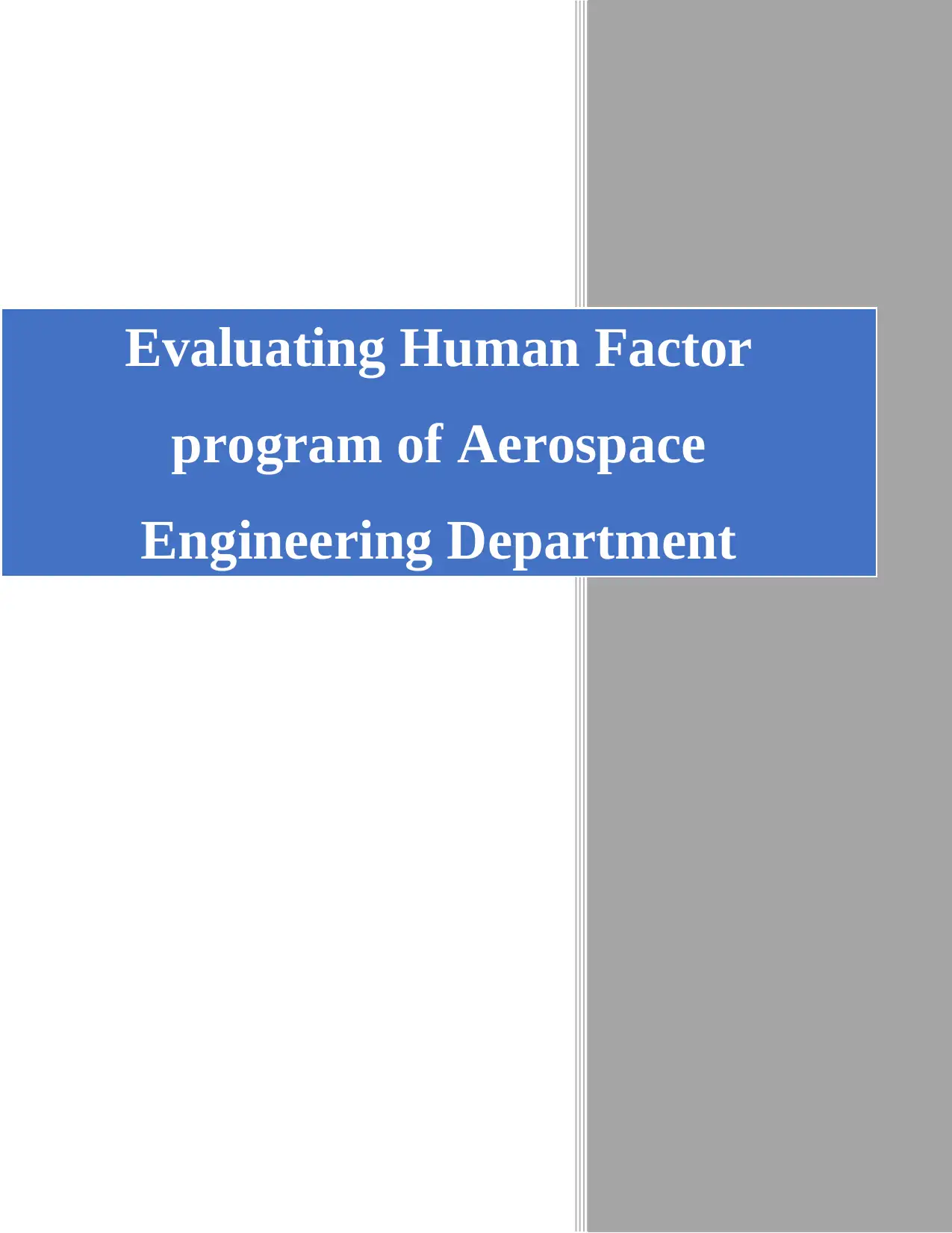
Evaluating Human Factor
program of Aerospace
Engineering Department
program of Aerospace
Engineering Department
Paraphrase This Document
Need a fresh take? Get an instant paraphrase of this document with our AI Paraphraser
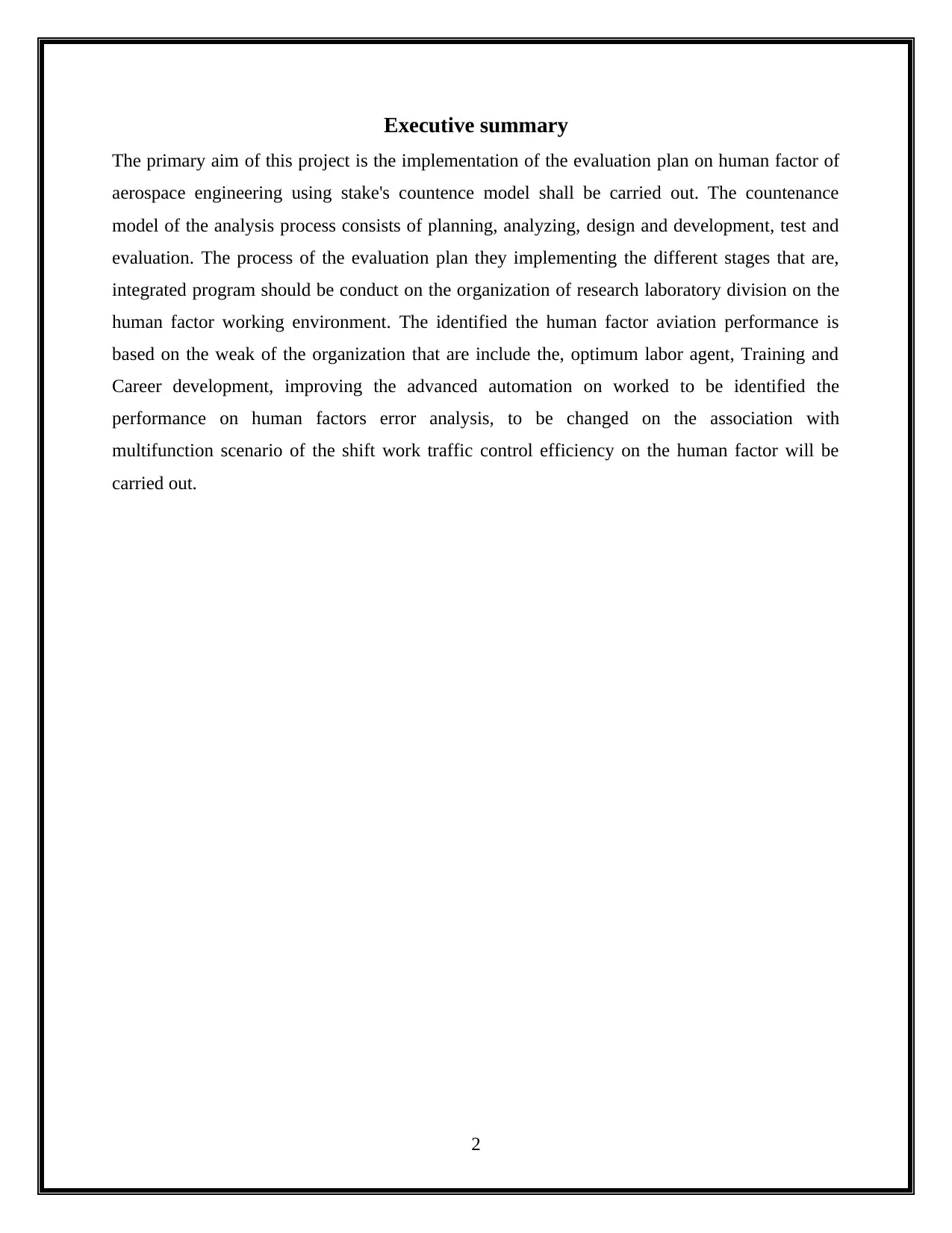
Executive summary
The primary aim of this project is the implementation of the evaluation plan on human factor of
aerospace engineering using stake's countence model shall be carried out. The countenance
model of the analysis process consists of planning, analyzing, design and development, test and
evaluation. The process of the evaluation plan they implementing the different stages that are,
integrated program should be conduct on the organization of research laboratory division on the
human factor working environment. The identified the human factor aviation performance is
based on the weak of the organization that are include the, optimum labor agent, Training and
Career development, improving the advanced automation on worked to be identified the
performance on human factors error analysis, to be changed on the association with
multifunction scenario of the shift work traffic control efficiency on the human factor will be
carried out.
2
The primary aim of this project is the implementation of the evaluation plan on human factor of
aerospace engineering using stake's countence model shall be carried out. The countenance
model of the analysis process consists of planning, analyzing, design and development, test and
evaluation. The process of the evaluation plan they implementing the different stages that are,
integrated program should be conduct on the organization of research laboratory division on the
human factor working environment. The identified the human factor aviation performance is
based on the weak of the organization that are include the, optimum labor agent, Training and
Career development, improving the advanced automation on worked to be identified the
performance on human factors error analysis, to be changed on the association with
multifunction scenario of the shift work traffic control efficiency on the human factor will be
carried out.
2

Table of Contents
Executive summary.........................................................................................................................2
Introduction......................................................................................................................................4
Background......................................................................................................................................5
Purpose & audiences........................................................................................................................6
Decision and questions....................................................................................................................7
Methods...........................................................................................................................................8
Evaluation plan implementation....................................................................................................10
Discussion and Recommendation..................................................................................................15
Conclusion.....................................................................................................................................16
Planner notes appendix..................................................................................................................16
Reference.......................................................................................................................................18
3
Executive summary.........................................................................................................................2
Introduction......................................................................................................................................4
Background......................................................................................................................................5
Purpose & audiences........................................................................................................................6
Decision and questions....................................................................................................................7
Methods...........................................................................................................................................8
Evaluation plan implementation....................................................................................................10
Discussion and Recommendation..................................................................................................15
Conclusion.....................................................................................................................................16
Planner notes appendix..................................................................................................................16
Reference.......................................................................................................................................18
3
⊘ This is a preview!⊘
Do you want full access?
Subscribe today to unlock all pages.

Trusted by 1+ million students worldwide
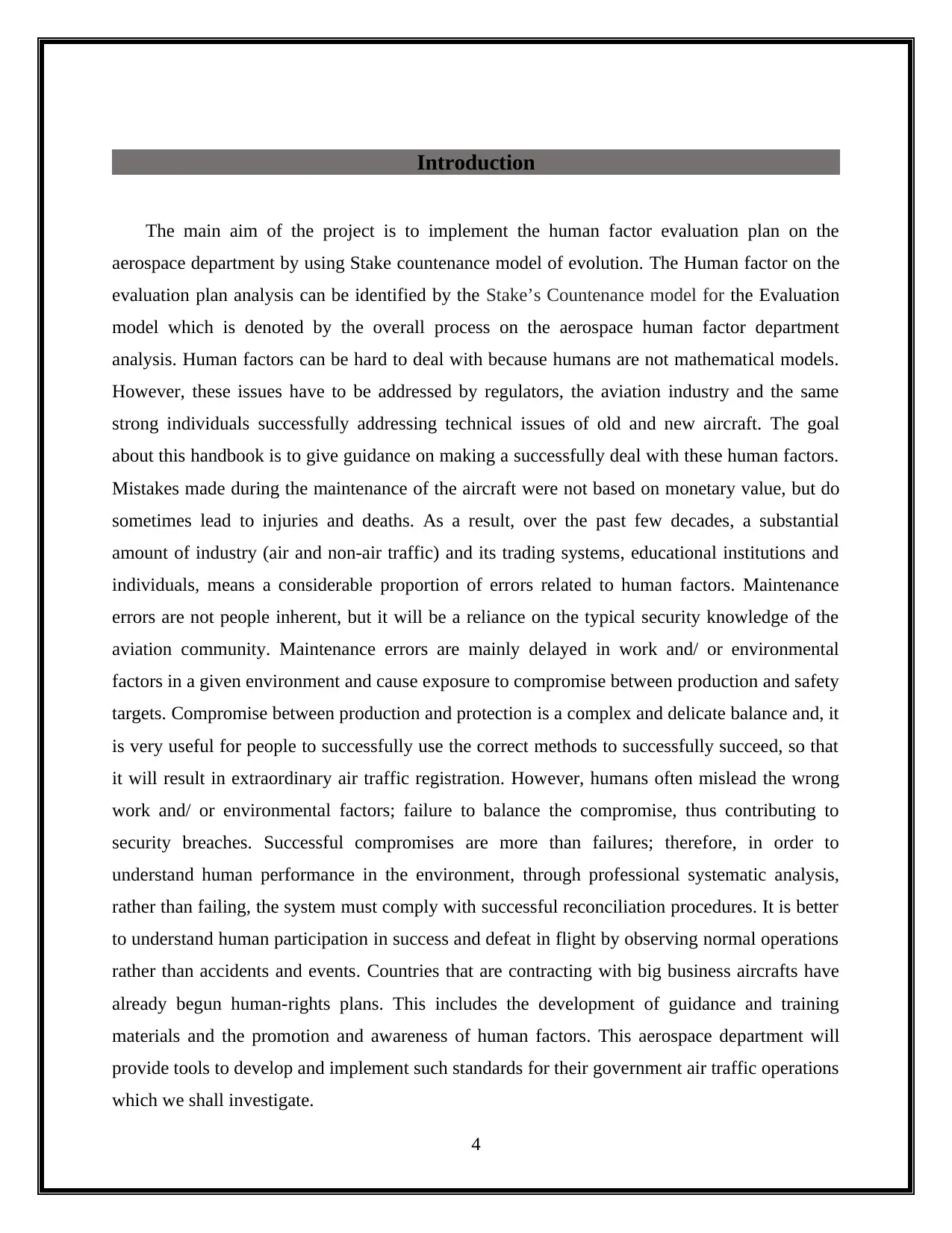
Introduction
The main aim of the project is to implement the human factor evaluation plan on the
aerospace department by using Stake countenance model of evolution. The Human factor on the
evaluation plan analysis can be identified by the Stake’s Countenance model for the Evaluation
model which is denoted by the overall process on the aerospace human factor department
analysis. Human factors can be hard to deal with because humans are not mathematical models.
However, these issues have to be addressed by regulators, the aviation industry and the same
strong individuals successfully addressing technical issues of old and new aircraft. The goal
about this handbook is to give guidance on making a successfully deal with these human factors.
Mistakes made during the maintenance of the aircraft were not based on monetary value, but do
sometimes lead to injuries and deaths. As a result, over the past few decades, a substantial
amount of industry (air and non-air traffic) and its trading systems, educational institutions and
individuals, means a considerable proportion of errors related to human factors. Maintenance
errors are not people inherent, but it will be a reliance on the typical security knowledge of the
aviation community. Maintenance errors are mainly delayed in work and/ or environmental
factors in a given environment and cause exposure to compromise between production and safety
targets. Compromise between production and protection is a complex and delicate balance and, it
is very useful for people to successfully use the correct methods to successfully succeed, so that
it will result in extraordinary air traffic registration. However, humans often mislead the wrong
work and/ or environmental factors; failure to balance the compromise, thus contributing to
security breaches. Successful compromises are more than failures; therefore, in order to
understand human performance in the environment, through professional systematic analysis,
rather than failing, the system must comply with successful reconciliation procedures. It is better
to understand human participation in success and defeat in flight by observing normal operations
rather than accidents and events. Countries that are contracting with big business aircrafts have
already begun human-rights plans. This includes the development of guidance and training
materials and the promotion and awareness of human factors. This aerospace department will
provide tools to develop and implement such standards for their government air traffic operations
which we shall investigate.
4
The main aim of the project is to implement the human factor evaluation plan on the
aerospace department by using Stake countenance model of evolution. The Human factor on the
evaluation plan analysis can be identified by the Stake’s Countenance model for the Evaluation
model which is denoted by the overall process on the aerospace human factor department
analysis. Human factors can be hard to deal with because humans are not mathematical models.
However, these issues have to be addressed by regulators, the aviation industry and the same
strong individuals successfully addressing technical issues of old and new aircraft. The goal
about this handbook is to give guidance on making a successfully deal with these human factors.
Mistakes made during the maintenance of the aircraft were not based on monetary value, but do
sometimes lead to injuries and deaths. As a result, over the past few decades, a substantial
amount of industry (air and non-air traffic) and its trading systems, educational institutions and
individuals, means a considerable proportion of errors related to human factors. Maintenance
errors are not people inherent, but it will be a reliance on the typical security knowledge of the
aviation community. Maintenance errors are mainly delayed in work and/ or environmental
factors in a given environment and cause exposure to compromise between production and safety
targets. Compromise between production and protection is a complex and delicate balance and, it
is very useful for people to successfully use the correct methods to successfully succeed, so that
it will result in extraordinary air traffic registration. However, humans often mislead the wrong
work and/ or environmental factors; failure to balance the compromise, thus contributing to
security breaches. Successful compromises are more than failures; therefore, in order to
understand human performance in the environment, through professional systematic analysis,
rather than failing, the system must comply with successful reconciliation procedures. It is better
to understand human participation in success and defeat in flight by observing normal operations
rather than accidents and events. Countries that are contracting with big business aircrafts have
already begun human-rights plans. This includes the development of guidance and training
materials and the promotion and awareness of human factors. This aerospace department will
provide tools to develop and implement such standards for their government air traffic operations
which we shall investigate.
4
Paraphrase This Document
Need a fresh take? Get an instant paraphrase of this document with our AI Paraphraser
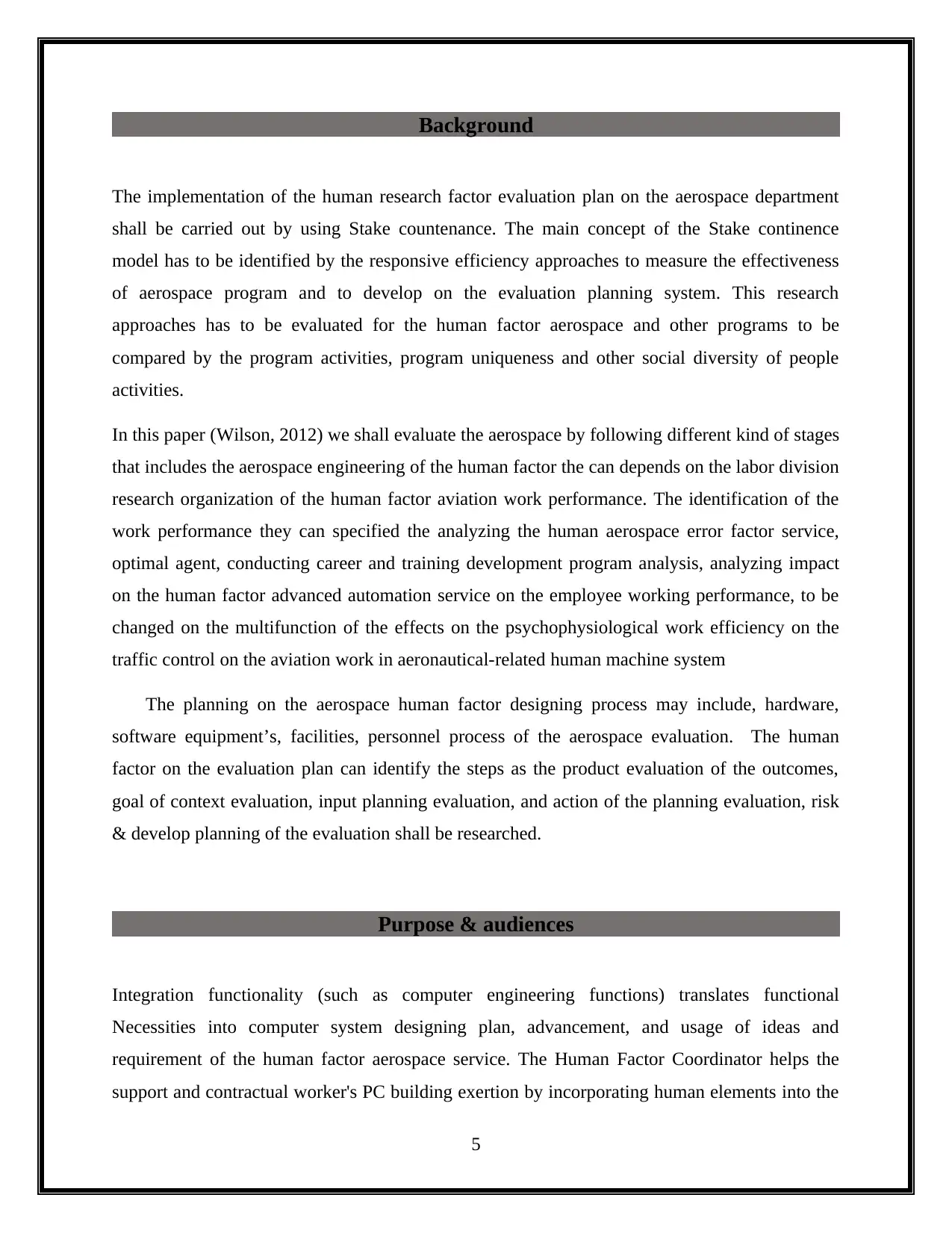
Background
The implementation of the human research factor evaluation plan on the aerospace department
shall be carried out by using Stake countenance. The main concept of the Stake continence
model has to be identified by the responsive efficiency approaches to measure the effectiveness
of aerospace program and to develop on the evaluation planning system. This research
approaches has to be evaluated for the human factor aerospace and other programs to be
compared by the program activities, program uniqueness and other social diversity of people
activities.
In this paper (Wilson, 2012) we shall evaluate the aerospace by following different kind of stages
that includes the aerospace engineering of the human factor the can depends on the labor division
research organization of the human factor aviation work performance. The identification of the
work performance they can specified the analyzing the human aerospace error factor service,
optimal agent, conducting career and training development program analysis, analyzing impact
on the human factor advanced automation service on the employee working performance, to be
changed on the multifunction of the effects on the psychophysiological work efficiency on the
traffic control on the aviation work in aeronautical-related human machine system
The planning on the aerospace human factor designing process may include, hardware,
software equipment’s, facilities, personnel process of the aerospace evaluation. The human
factor on the evaluation plan can identify the steps as the product evaluation of the outcomes,
goal of context evaluation, input planning evaluation, and action of the planning evaluation, risk
& develop planning of the evaluation shall be researched.
Purpose & audiences
Integration functionality (such as computer engineering functions) translates functional
Necessities into computer system designing plan, advancement, and usage of ideas and
requirement of the human factor aerospace service. The Human Factor Coordinator helps the
support and contractual worker's PC building exertion by incorporating human elements into the
5
The implementation of the human research factor evaluation plan on the aerospace department
shall be carried out by using Stake countenance. The main concept of the Stake continence
model has to be identified by the responsive efficiency approaches to measure the effectiveness
of aerospace program and to develop on the evaluation planning system. This research
approaches has to be evaluated for the human factor aerospace and other programs to be
compared by the program activities, program uniqueness and other social diversity of people
activities.
In this paper (Wilson, 2012) we shall evaluate the aerospace by following different kind of stages
that includes the aerospace engineering of the human factor the can depends on the labor division
research organization of the human factor aviation work performance. The identification of the
work performance they can specified the analyzing the human aerospace error factor service,
optimal agent, conducting career and training development program analysis, analyzing impact
on the human factor advanced automation service on the employee working performance, to be
changed on the multifunction of the effects on the psychophysiological work efficiency on the
traffic control on the aviation work in aeronautical-related human machine system
The planning on the aerospace human factor designing process may include, hardware,
software equipment’s, facilities, personnel process of the aerospace evaluation. The human
factor on the evaluation plan can identify the steps as the product evaluation of the outcomes,
goal of context evaluation, input planning evaluation, and action of the planning evaluation, risk
& develop planning of the evaluation shall be researched.
Purpose & audiences
Integration functionality (such as computer engineering functions) translates functional
Necessities into computer system designing plan, advancement, and usage of ideas and
requirement of the human factor aerospace service. The Human Factor Coordinator helps the
support and contractual worker's PC building exertion by incorporating human elements into the
5
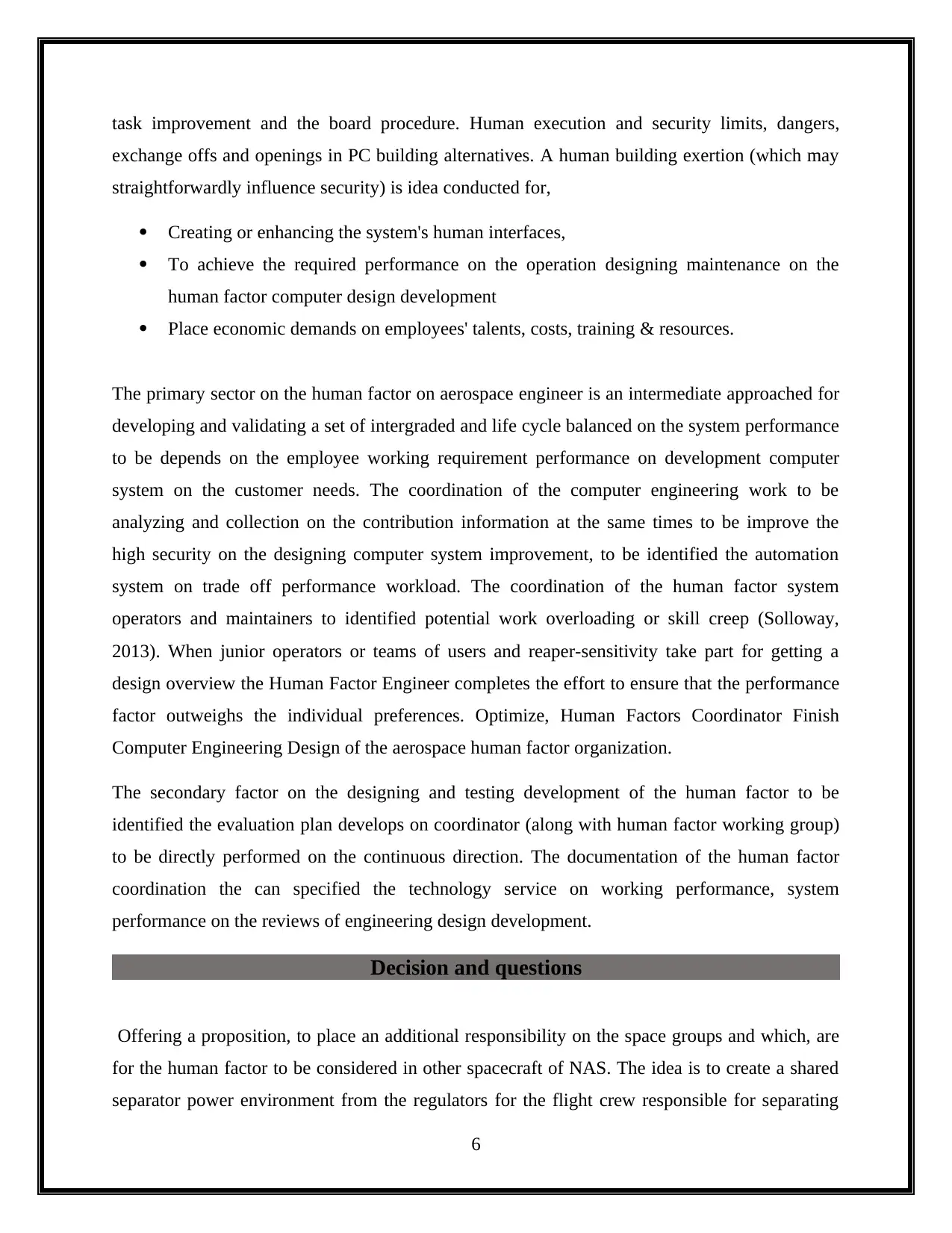
task improvement and the board procedure. Human execution and security limits, dangers,
exchange offs and openings in PC building alternatives. A human building exertion (which may
straightforwardly influence security) is idea conducted for,
Creating or enhancing the system's human interfaces,
To achieve the required performance on the operation designing maintenance on the
human factor computer design development
Place economic demands on employees' talents, costs, training & resources.
The primary sector on the human factor on aerospace engineer is an intermediate approached for
developing and validating a set of intergraded and life cycle balanced on the system performance
to be depends on the employee working requirement performance on development computer
system on the customer needs. The coordination of the computer engineering work to be
analyzing and collection on the contribution information at the same times to be improve the
high security on the designing computer system improvement, to be identified the automation
system on trade off performance workload. The coordination of the human factor system
operators and maintainers to identified potential work overloading or skill creep (Solloway,
2013). When junior operators or teams of users and reaper-sensitivity take part for getting a
design overview the Human Factor Engineer completes the effort to ensure that the performance
factor outweighs the individual preferences. Optimize, Human Factors Coordinator Finish
Computer Engineering Design of the aerospace human factor organization.
The secondary factor on the designing and testing development of the human factor to be
identified the evaluation plan develops on coordinator (along with human factor working group)
to be directly performed on the continuous direction. The documentation of the human factor
coordination the can specified the technology service on working performance, system
performance on the reviews of engineering design development.
Decision and questions
Offering a proposition, to place an additional responsibility on the space groups and which, are
for the human factor to be considered in other spacecraft of NAS. The idea is to create a shared
separator power environment from the regulators for the flight crew responsible for separating
6
exchange offs and openings in PC building alternatives. A human building exertion (which may
straightforwardly influence security) is idea conducted for,
Creating or enhancing the system's human interfaces,
To achieve the required performance on the operation designing maintenance on the
human factor computer design development
Place economic demands on employees' talents, costs, training & resources.
The primary sector on the human factor on aerospace engineer is an intermediate approached for
developing and validating a set of intergraded and life cycle balanced on the system performance
to be depends on the employee working requirement performance on development computer
system on the customer needs. The coordination of the computer engineering work to be
analyzing and collection on the contribution information at the same times to be improve the
high security on the designing computer system improvement, to be identified the automation
system on trade off performance workload. The coordination of the human factor system
operators and maintainers to identified potential work overloading or skill creep (Solloway,
2013). When junior operators or teams of users and reaper-sensitivity take part for getting a
design overview the Human Factor Engineer completes the effort to ensure that the performance
factor outweighs the individual preferences. Optimize, Human Factors Coordinator Finish
Computer Engineering Design of the aerospace human factor organization.
The secondary factor on the designing and testing development of the human factor to be
identified the evaluation plan develops on coordinator (along with human factor working group)
to be directly performed on the continuous direction. The documentation of the human factor
coordination the can specified the technology service on working performance, system
performance on the reviews of engineering design development.
Decision and questions
Offering a proposition, to place an additional responsibility on the space groups and which, are
for the human factor to be considered in other spacecraft of NAS. The idea is to create a shared
separator power environment from the regulators for the flight crew responsible for separating
6
⊘ This is a preview!⊘
Do you want full access?
Subscribe today to unlock all pages.

Trusted by 1+ million students worldwide
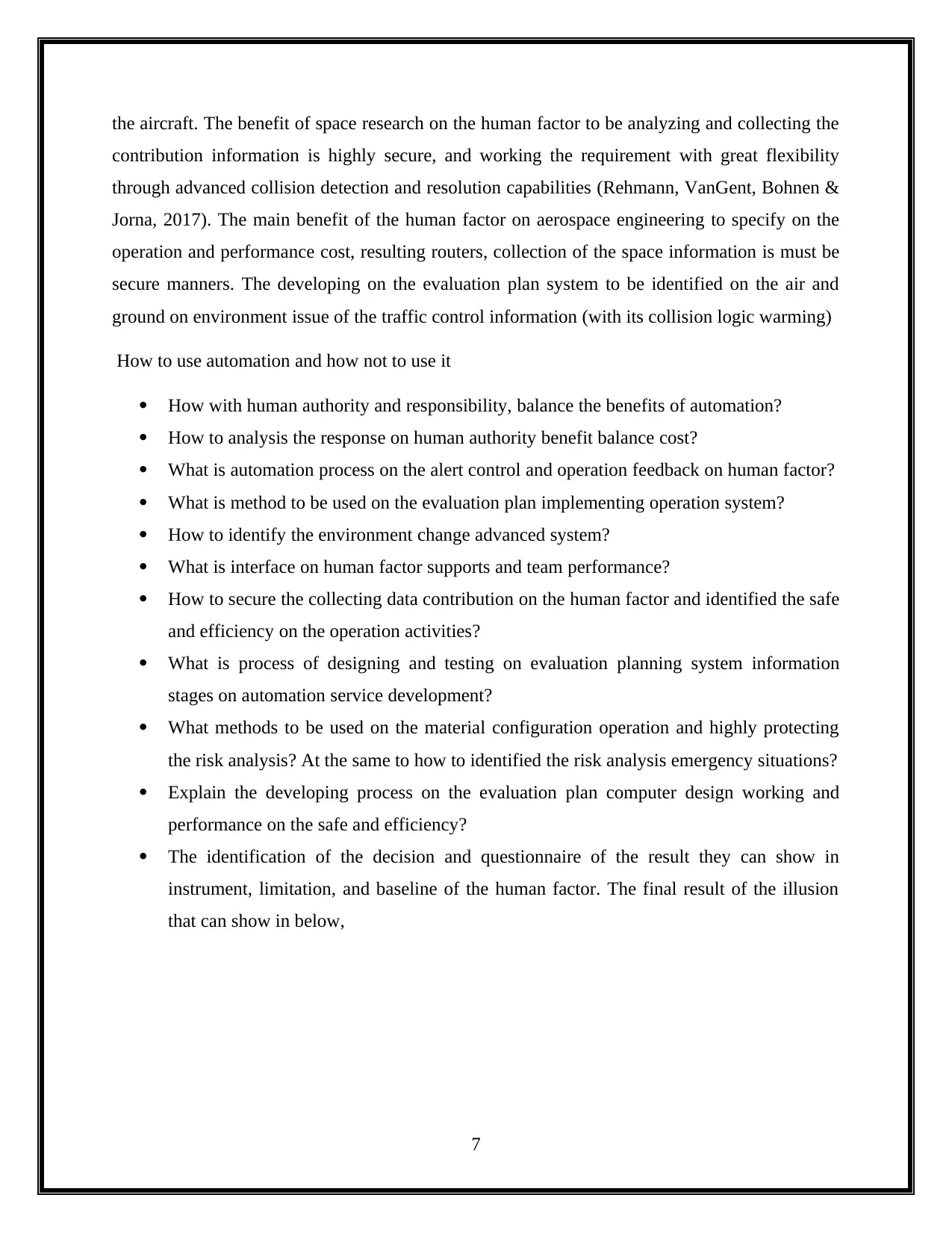
the aircraft. The benefit of space research on the human factor to be analyzing and collecting the
contribution information is highly secure, and working the requirement with great flexibility
through advanced collision detection and resolution capabilities (Rehmann, VanGent, Bohnen &
Jorna, 2017). The main benefit of the human factor on aerospace engineering to specify on the
operation and performance cost, resulting routers, collection of the space information is must be
secure manners. The developing on the evaluation plan system to be identified on the air and
ground on environment issue of the traffic control information (with its collision logic warming)
How to use automation and how not to use it
How with human authority and responsibility, balance the benefits of automation?
How to analysis the response on human authority benefit balance cost?
What is automation process on the alert control and operation feedback on human factor?
What is method to be used on the evaluation plan implementing operation system?
How to identify the environment change advanced system?
What is interface on human factor supports and team performance?
How to secure the collecting data contribution on the human factor and identified the safe
and efficiency on the operation activities?
What is process of designing and testing on evaluation planning system information
stages on automation service development?
What methods to be used on the material configuration operation and highly protecting
the risk analysis? At the same to how to identified the risk analysis emergency situations?
Explain the developing process on the evaluation plan computer design working and
performance on the safe and efficiency?
The identification of the decision and questionnaire of the result they can show in
instrument, limitation, and baseline of the human factor. The final result of the illusion
that can show in below,
7
contribution information is highly secure, and working the requirement with great flexibility
through advanced collision detection and resolution capabilities (Rehmann, VanGent, Bohnen &
Jorna, 2017). The main benefit of the human factor on aerospace engineering to specify on the
operation and performance cost, resulting routers, collection of the space information is must be
secure manners. The developing on the evaluation plan system to be identified on the air and
ground on environment issue of the traffic control information (with its collision logic warming)
How to use automation and how not to use it
How with human authority and responsibility, balance the benefits of automation?
How to analysis the response on human authority benefit balance cost?
What is automation process on the alert control and operation feedback on human factor?
What is method to be used on the evaluation plan implementing operation system?
How to identify the environment change advanced system?
What is interface on human factor supports and team performance?
How to secure the collecting data contribution on the human factor and identified the safe
and efficiency on the operation activities?
What is process of designing and testing on evaluation planning system information
stages on automation service development?
What methods to be used on the material configuration operation and highly protecting
the risk analysis? At the same to how to identified the risk analysis emergency situations?
Explain the developing process on the evaluation plan computer design working and
performance on the safe and efficiency?
The identification of the decision and questionnaire of the result they can show in
instrument, limitation, and baseline of the human factor. The final result of the illusion
that can show in below,
7
Paraphrase This Document
Need a fresh take? Get an instant paraphrase of this document with our AI Paraphraser
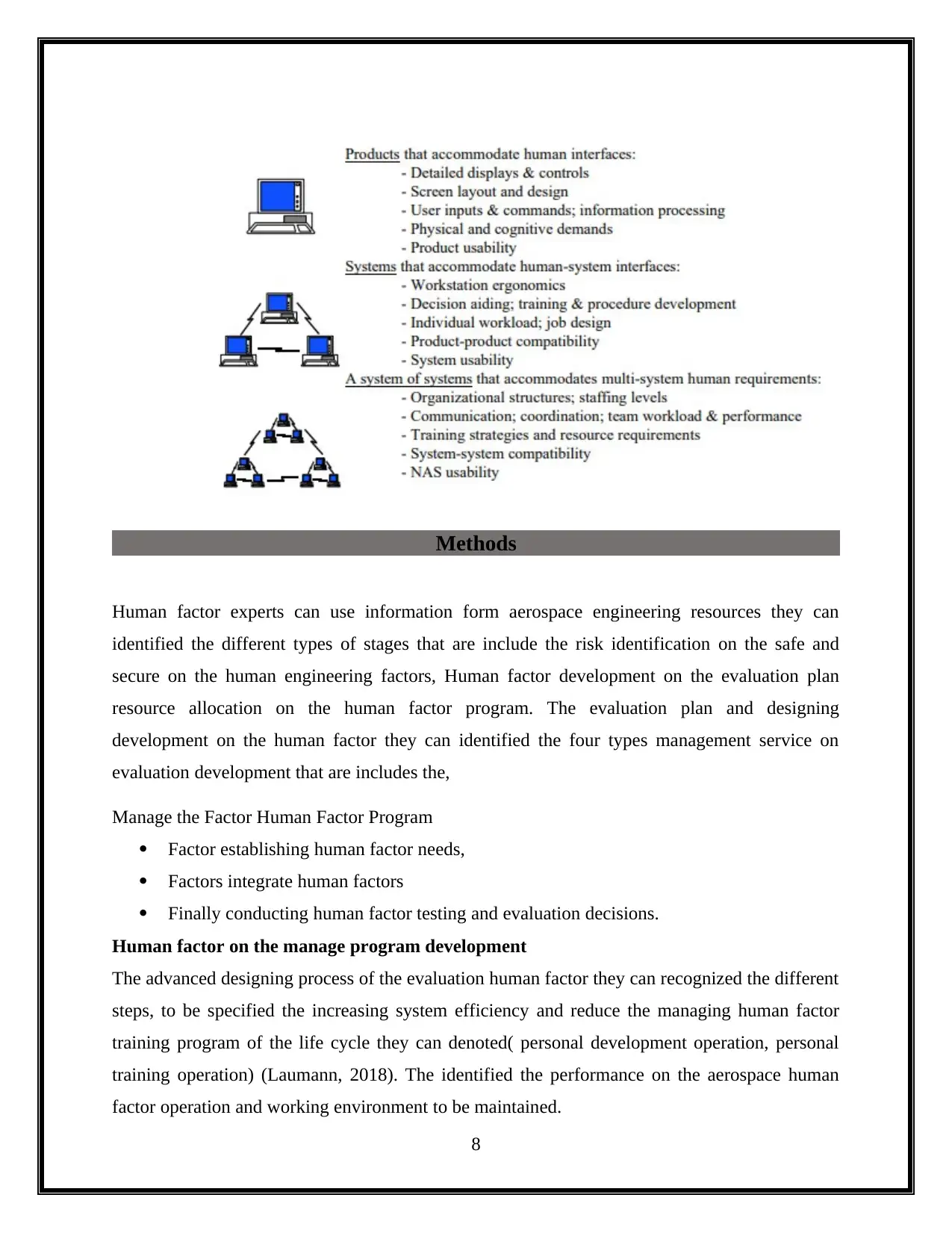
Methods
Human factor experts can use information form aerospace engineering resources they can
identified the different types of stages that are include the risk identification on the safe and
secure on the human engineering factors, Human factor development on the evaluation plan
resource allocation on the human factor program. The evaluation plan and designing
development on the human factor they can identified the four types management service on
evaluation development that are includes the,
Manage the Factor Human Factor Program
Factor establishing human factor needs,
Factors integrate human factors
Finally conducting human factor testing and evaluation decisions.
Human factor on the manage program development
The advanced designing process of the evaluation human factor they can recognized the different
steps, to be specified the increasing system efficiency and reduce the managing human factor
training program of the life cycle they can denoted( personal development operation, personal
training operation) (Laumann, 2018). The identified the performance on the aerospace human
factor operation and working environment to be maintained.
8
Human factor experts can use information form aerospace engineering resources they can
identified the different types of stages that are include the risk identification on the safe and
secure on the human engineering factors, Human factor development on the evaluation plan
resource allocation on the human factor program. The evaluation plan and designing
development on the human factor they can identified the four types management service on
evaluation development that are includes the,
Manage the Factor Human Factor Program
Factor establishing human factor needs,
Factors integrate human factors
Finally conducting human factor testing and evaluation decisions.
Human factor on the manage program development
The advanced designing process of the evaluation human factor they can recognized the different
steps, to be specified the increasing system efficiency and reduce the managing human factor
training program of the life cycle they can denoted( personal development operation, personal
training operation) (Laumann, 2018). The identified the performance on the aerospace human
factor operation and working environment to be maintained.
8
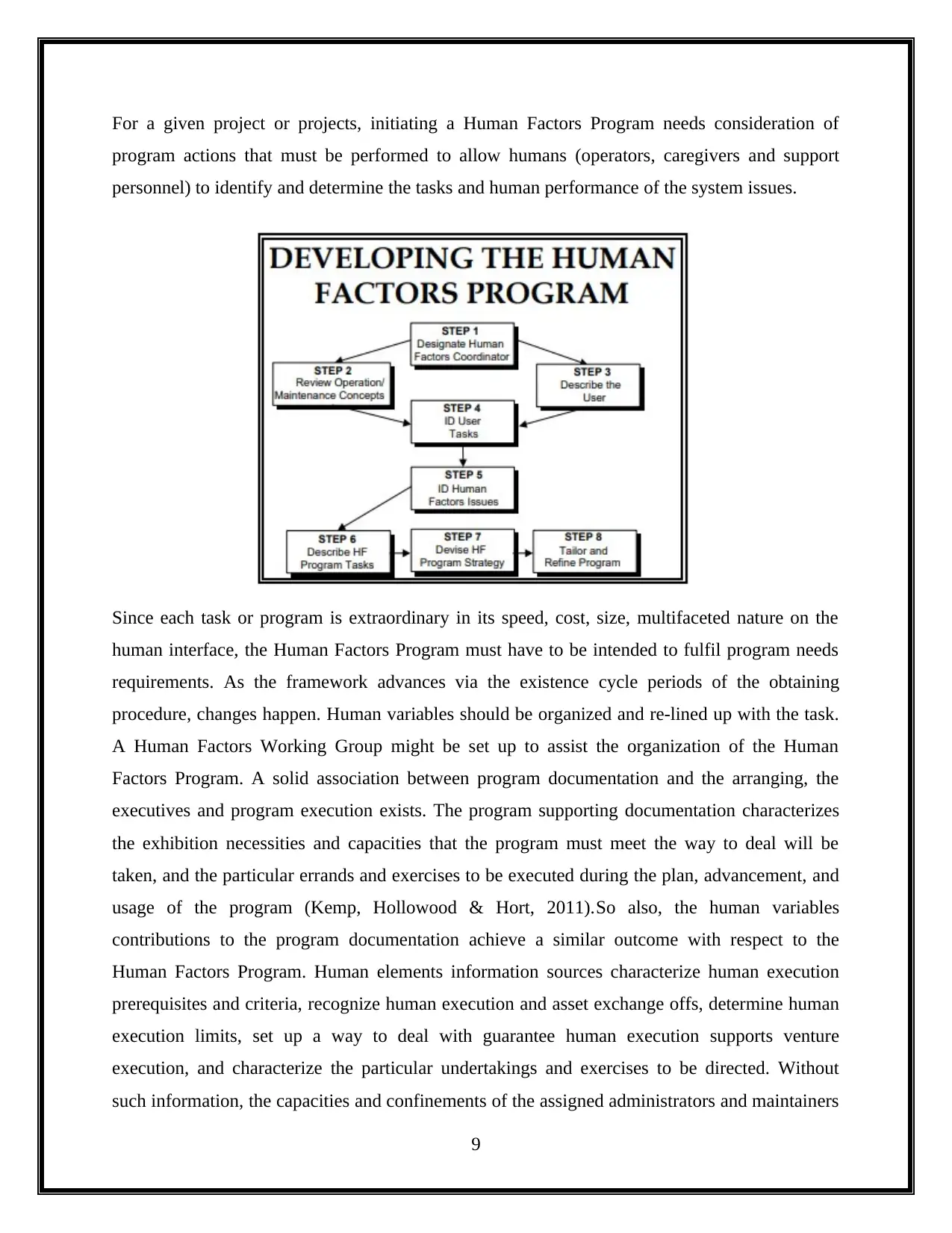
For a given project or projects, initiating a Human Factors Program needs consideration of
program actions that must be performed to allow humans (operators, caregivers and support
personnel) to identify and determine the tasks and human performance of the system issues.
Since each task or program is extraordinary in its speed, cost, size, multifaceted nature on the
human interface, the Human Factors Program must have to be intended to fulfil program needs
requirements. As the framework advances via the existence cycle periods of the obtaining
procedure, changes happen. Human variables should be organized and re-lined up with the task.
A Human Factors Working Group might be set up to assist the organization of the Human
Factors Program. A solid association between program documentation and the arranging, the
executives and program execution exists. The program supporting documentation characterizes
the exhibition necessities and capacities that the program must meet the way to deal will be
taken, and the particular errands and exercises to be executed during the plan, advancement, and
usage of the program (Kemp, Hollowood & Hort, 2011).So also, the human variables
contributions to the program documentation achieve a similar outcome with respect to the
Human Factors Program. Human elements information sources characterize human execution
prerequisites and criteria, recognize human execution and asset exchange offs, determine human
execution limits, set up a way to deal with guarantee human execution supports venture
execution, and characterize the particular undertakings and exercises to be directed. Without
such information, the capacities and confinements of the assigned administrators and maintainers
9
program actions that must be performed to allow humans (operators, caregivers and support
personnel) to identify and determine the tasks and human performance of the system issues.
Since each task or program is extraordinary in its speed, cost, size, multifaceted nature on the
human interface, the Human Factors Program must have to be intended to fulfil program needs
requirements. As the framework advances via the existence cycle periods of the obtaining
procedure, changes happen. Human variables should be organized and re-lined up with the task.
A Human Factors Working Group might be set up to assist the organization of the Human
Factors Program. A solid association between program documentation and the arranging, the
executives and program execution exists. The program supporting documentation characterizes
the exhibition necessities and capacities that the program must meet the way to deal will be
taken, and the particular errands and exercises to be executed during the plan, advancement, and
usage of the program (Kemp, Hollowood & Hort, 2011).So also, the human variables
contributions to the program documentation achieve a similar outcome with respect to the
Human Factors Program. Human elements information sources characterize human execution
prerequisites and criteria, recognize human execution and asset exchange offs, determine human
execution limits, set up a way to deal with guarantee human execution supports venture
execution, and characterize the particular undertakings and exercises to be directed. Without
such information, the capacities and confinements of the assigned administrators and maintainers
9
⊘ This is a preview!⊘
Do you want full access?
Subscribe today to unlock all pages.

Trusted by 1+ million students worldwide
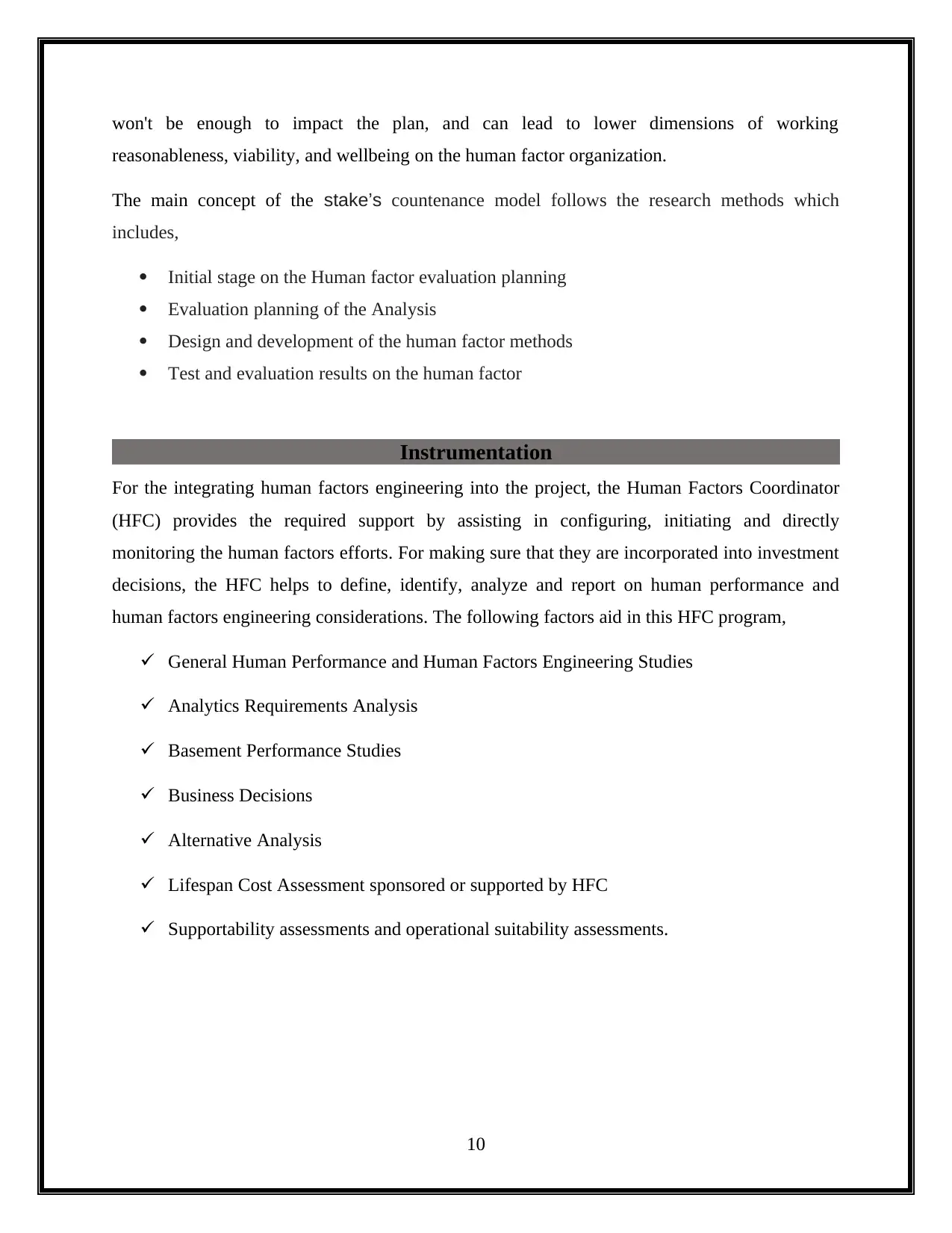
won't be enough to impact the plan, and can lead to lower dimensions of working
reasonableness, viability, and wellbeing on the human factor organization.
The main concept of the stake’s countenance model follows the research methods which
includes,
Initial stage on the Human factor evaluation planning
Evaluation planning of the Analysis
Design and development of the human factor methods
Test and evaluation results on the human factor
Instrumentation
For the integrating human factors engineering into the project, the Human Factors Coordinator
(HFC) provides the required support by assisting in configuring, initiating and directly
monitoring the human factors efforts. For making sure that they are incorporated into investment
decisions, the HFC helps to define, identify, analyze and report on human performance and
human factors engineering considerations. The following factors aid in this HFC program,
General Human Performance and Human Factors Engineering Studies
Analytics Requirements Analysis
Basement Performance Studies
Business Decisions
Alternative Analysis
Lifespan Cost Assessment sponsored or supported by HFC
Supportability assessments and operational suitability assessments.
10
reasonableness, viability, and wellbeing on the human factor organization.
The main concept of the stake’s countenance model follows the research methods which
includes,
Initial stage on the Human factor evaluation planning
Evaluation planning of the Analysis
Design and development of the human factor methods
Test and evaluation results on the human factor
Instrumentation
For the integrating human factors engineering into the project, the Human Factors Coordinator
(HFC) provides the required support by assisting in configuring, initiating and directly
monitoring the human factors efforts. For making sure that they are incorporated into investment
decisions, the HFC helps to define, identify, analyze and report on human performance and
human factors engineering considerations. The following factors aid in this HFC program,
General Human Performance and Human Factors Engineering Studies
Analytics Requirements Analysis
Basement Performance Studies
Business Decisions
Alternative Analysis
Lifespan Cost Assessment sponsored or supported by HFC
Supportability assessments and operational suitability assessments.
10
Paraphrase This Document
Need a fresh take? Get an instant paraphrase of this document with our AI Paraphraser
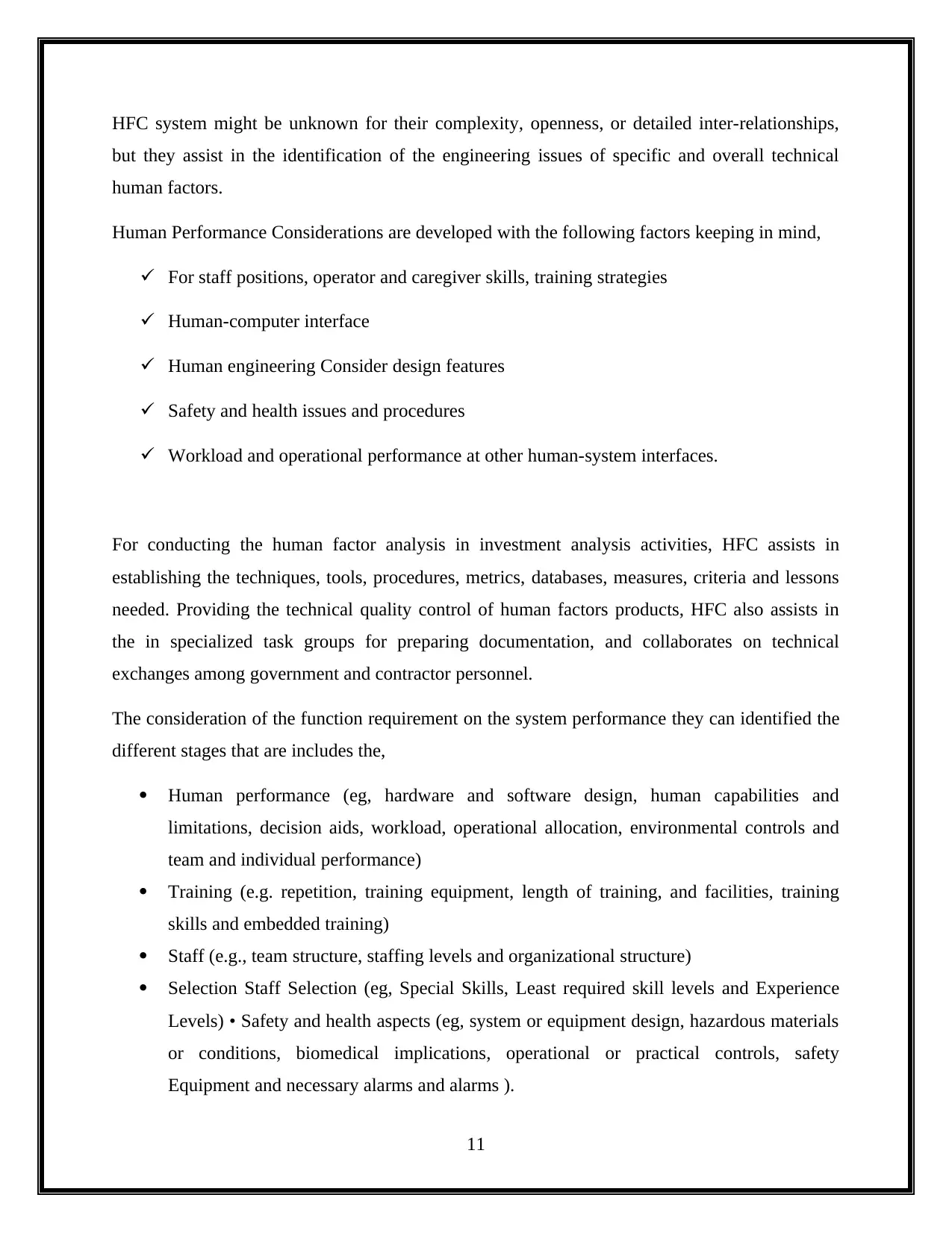
HFC system might be unknown for their complexity, openness, or detailed inter-relationships,
but they assist in the identification of the engineering issues of specific and overall technical
human factors.
Human Performance Considerations are developed with the following factors keeping in mind,
For staff positions, operator and caregiver skills, training strategies
Human-computer interface
Human engineering Consider design features
Safety and health issues and procedures
Workload and operational performance at other human-system interfaces.
For conducting the human factor analysis in investment analysis activities, HFC assists in
establishing the techniques, tools, procedures, metrics, databases, measures, criteria and lessons
needed. Providing the technical quality control of human factors products, HFC also assists in
the in specialized task groups for preparing documentation, and collaborates on technical
exchanges among government and contractor personnel.
The consideration of the function requirement on the system performance they can identified the
different stages that are includes the,
Human performance (eg, hardware and software design, human capabilities and
limitations, decision aids, workload, operational allocation, environmental controls and
team and individual performance)
Training (e.g. repetition, training equipment, length of training, and facilities, training
skills and embedded training)
Staff (e.g., team structure, staffing levels and organizational structure)
Selection Staff Selection (eg, Special Skills, Least required skill levels and Experience
Levels) • Safety and health aspects (eg, system or equipment design, hazardous materials
or conditions, biomedical implications, operational or practical controls, safety
Equipment and necessary alarms and alarms ).
11
but they assist in the identification of the engineering issues of specific and overall technical
human factors.
Human Performance Considerations are developed with the following factors keeping in mind,
For staff positions, operator and caregiver skills, training strategies
Human-computer interface
Human engineering Consider design features
Safety and health issues and procedures
Workload and operational performance at other human-system interfaces.
For conducting the human factor analysis in investment analysis activities, HFC assists in
establishing the techniques, tools, procedures, metrics, databases, measures, criteria and lessons
needed. Providing the technical quality control of human factors products, HFC also assists in
the in specialized task groups for preparing documentation, and collaborates on technical
exchanges among government and contractor personnel.
The consideration of the function requirement on the system performance they can identified the
different stages that are includes the,
Human performance (eg, hardware and software design, human capabilities and
limitations, decision aids, workload, operational allocation, environmental controls and
team and individual performance)
Training (e.g. repetition, training equipment, length of training, and facilities, training
skills and embedded training)
Staff (e.g., team structure, staffing levels and organizational structure)
Selection Staff Selection (eg, Special Skills, Least required skill levels and Experience
Levels) • Safety and health aspects (eg, system or equipment design, hazardous materials
or conditions, biomedical implications, operational or practical controls, safety
Equipment and necessary alarms and alarms ).
11
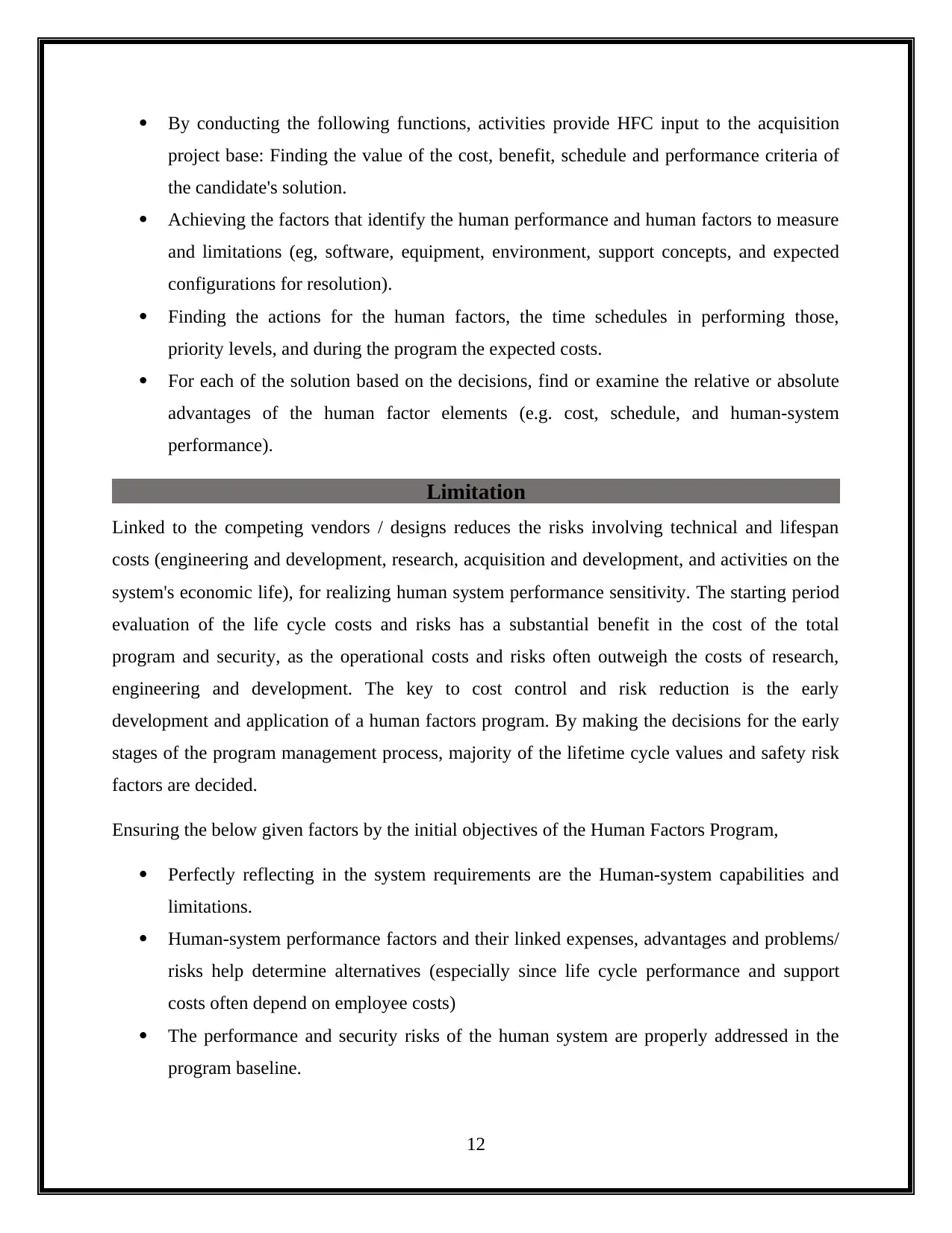
By conducting the following functions, activities provide HFC input to the acquisition
project base: Finding the value of the cost, benefit, schedule and performance criteria of
the candidate's solution.
Achieving the factors that identify the human performance and human factors to measure
and limitations (eg, software, equipment, environment, support concepts, and expected
configurations for resolution).
Finding the actions for the human factors, the time schedules in performing those,
priority levels, and during the program the expected costs.
For each of the solution based on the decisions, find or examine the relative or absolute
advantages of the human factor elements (e.g. cost, schedule, and human-system
performance).
Limitation
Linked to the competing vendors / designs reduces the risks involving technical and lifespan
costs (engineering and development, research, acquisition and development, and activities on the
system's economic life), for realizing human system performance sensitivity. The starting period
evaluation of the life cycle costs and risks has a substantial benefit in the cost of the total
program and security, as the operational costs and risks often outweigh the costs of research,
engineering and development. The key to cost control and risk reduction is the early
development and application of a human factors program. By making the decisions for the early
stages of the program management process, majority of the lifetime cycle values and safety risk
factors are decided.
Ensuring the below given factors by the initial objectives of the Human Factors Program,
Perfectly reflecting in the system requirements are the Human-system capabilities and
limitations.
Human-system performance factors and their linked expenses, advantages and problems/
risks help determine alternatives (especially since life cycle performance and support
costs often depend on employee costs)
The performance and security risks of the human system are properly addressed in the
program baseline.
12
project base: Finding the value of the cost, benefit, schedule and performance criteria of
the candidate's solution.
Achieving the factors that identify the human performance and human factors to measure
and limitations (eg, software, equipment, environment, support concepts, and expected
configurations for resolution).
Finding the actions for the human factors, the time schedules in performing those,
priority levels, and during the program the expected costs.
For each of the solution based on the decisions, find or examine the relative or absolute
advantages of the human factor elements (e.g. cost, schedule, and human-system
performance).
Limitation
Linked to the competing vendors / designs reduces the risks involving technical and lifespan
costs (engineering and development, research, acquisition and development, and activities on the
system's economic life), for realizing human system performance sensitivity. The starting period
evaluation of the life cycle costs and risks has a substantial benefit in the cost of the total
program and security, as the operational costs and risks often outweigh the costs of research,
engineering and development. The key to cost control and risk reduction is the early
development and application of a human factors program. By making the decisions for the early
stages of the program management process, majority of the lifetime cycle values and safety risk
factors are decided.
Ensuring the below given factors by the initial objectives of the Human Factors Program,
Perfectly reflecting in the system requirements are the Human-system capabilities and
limitations.
Human-system performance factors and their linked expenses, advantages and problems/
risks help determine alternatives (especially since life cycle performance and support
costs often depend on employee costs)
The performance and security risks of the human system are properly addressed in the
program baseline.
12
⊘ This is a preview!⊘
Do you want full access?
Subscribe today to unlock all pages.

Trusted by 1+ million students worldwide
1 out of 22
Related Documents
Your All-in-One AI-Powered Toolkit for Academic Success.
+13062052269
info@desklib.com
Available 24*7 on WhatsApp / Email
![[object Object]](/_next/static/media/star-bottom.7253800d.svg)
Unlock your academic potential
Copyright © 2020–2025 A2Z Services. All Rights Reserved. Developed and managed by ZUCOL.




